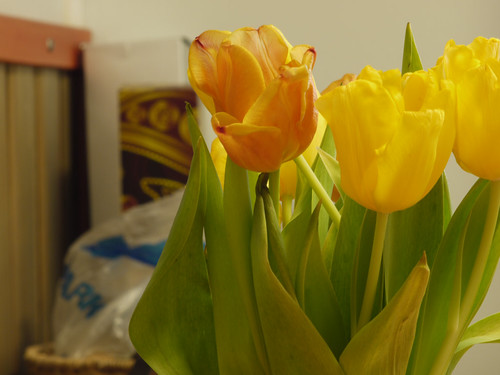I often hear people confused about lenses and formats:
will a 50mm on a 4/3 look like a 100mm on a full frame camera?
what effect does the multiplier have on full frame lenses when used on 4/3
surely just cropping the middle is not what it looks like...
Since this topic goes round and round with people endlessly getting confused I thought I would try to answer it here.
Any lens at a constant aperture diameter always looks the same as long as you are seeing the same angle of view. So yes, a 50mm on a 4/3 will look exactly like a 100mm on a 35mm taken from the same spot with the same sized aperture.
Some of the feed back on my blog indicates that a graph just confuses people and more complex stuff like maths (formula which boils down to 4 divided by 2 equals 2) just sends people into a spin. So rather than reiterate that the division x2 essentially is accurate enough (gosh I think I just did) I'll show it graphically, since a picture is worth a thousand words.
So to answer this question I thought I would provide six pictures (equivalent to a verbal length of six thousand words) to try to clear this up for those how are still trying to push the wrong ideas down others peoples throats.
method
I put the camera on a tripod and did not move anything, I took 3 images only replacing the lens and focusing each on the same point and set the aperture to the same size on all shots. I used the following lenses, all Olympus OM series:
- 21mm
- 50mm
- 100mm
No matter how wide a 21mm lens is on a full frame camera ... if you take a wide picture and crop out the middle then its not wide anymore is it?
This is exactly what the effect of putting a 21mm wide angle on a 4/3 sensor camera is.
Ohh ... it can't be that simple can it?
well, yes actually.
First the overviews:
21mm (normal angle of view, equal to about a 50mm on a full frame)

50mm (which on 4/3 is like a 100mm on full frame, and looking exactly like a crop of the above image from the 21mm lens)

100mm and this also looks like a crop of the above or a x4 crop out of the 21mm above

If that's not convincing enough, I thought I'd actually crop the guts out of them and present that here too:
21mm (this one has to be cropped the most ... of course this is more or less 100% as the 4000 pixels became only 744 pixels by the time I've done the crop to essentially x4 the focal lenght {21 x 4 is nearly 100})

50mm (cropped essentially to half the frame width / height of the 100)

100mm (and the image from the 100 simply scaled down to be the same number of pixels as the crops)

do you see any differences?
So you can expect that any 35mm lens used on a 4/3 camera will look exactly like cropping it down to half the width and half the height.
Even if you start talking about focal length multipliers (god knows why), its worth pointing out that DoF is a function of the diameter of the hole (the pupil diameter) and essentially nothing at all to do with the focal length.
I've put a page comparing this on my 20D compared to a compact camera here. But as you can spot in the above all the DoF are the same. Well the reason for that is that I used different f-stops but the same diameter of aperture on all the above.
F-Stop is quite simply the focal length divided by the diameter of the hole. So if you have a 21mm lens then the hole size at f3.5 is 6 mm (21 divided by 3.5 = 6 sorry about the complex maths here). It works out that for the other lenses its:
| 50mm | f8 | 6.25 |
| 100mm | f16 | 6.25 |
which isn't quite perfect, but close enough.
So again looking at the above, for the various focal lengths you can see that the DoF in the image is actually the same when you just crop them to be the same.
I hope these images (and the extra words) help you to understand this point better.
Folks also ask another question which is "is f1.7 on a 20mm on a 4/3 camera then equal to f1.7 on a full frame?"
the answer to that is no, its acutally more like f4 on a full frame in terms of depth of field. Why? well that's another blog post :-)











5 comments:
Hi,
look at this
http://zone-10.com/cmsm/index.php?option=com_content&task=view&id=482&Itemid=1
Petraslinas.
Excellent post!
The often forgotten fact is that it's the diameter that stays constant, not the f-stop. And of course, the later is proportional to said diameter *and* the focal length!
It also partly explains how come f64 in a LF 300mm lens doesn't necessarily cause difraction problems while giving good dof, and the same f-stop in a equivalent 35mm lens is a virtual guarantee of colour fringe mess!
Good post, very thought provoking. I only recently learned that the f-number is the ratio of the focal length to the aperture diameter. When you pointed out that the DOF is dependent on the size of the pupil rather than the f-number, everything made sense!
juarez
glad you liked it. For some reason I've just barely seen anything that puts the issue into perspective
Excellent article. A picture (or 3) is worth a thousand words.
Post a Comment